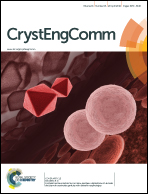Water-soluble, highly emissive, color-tunable, and stable Cu-doped ZnSeS/ZnS core/shell nanocrystals†
Abstract
Water-soluble, highly emissive, color-tunable, and stable Cu:ZnSeS/ZnS core/shell doped nanocrystals (d-dots) with pure dopant emission have been synthesized through a simple aqueous synthetic route. The influence of various experimental variables, including introduction of chloride ions, amount of mercaptopropanoic acid (MPA), pH value and Cu-doping concentration, on the optical properties of Cu dopant emission have been systematically investigated. Through epitaxial growth of a ZnS shell on Cu:ZnSeS cores, the fabricated Cu:ZnSeS/ZnS d-dots exhibit a high PL QY of up to 40%, which is the highest ever reported for any type of water-soluble Cu-doped selenide-based II–VI semiconductor nanocrystals (NCs). Moreover, the serious photostability problem of Cu-based d-dots in the presence of air and light is solved and the quenching of the excitonic emission is suppressed as well. The stable testing of these highly luminescent d-dots shows that the Cu:ZnSeS/ZnS d-dots have better photostability and preserve more than ~90% of the initial intensity in the presence of air and light 30 days later. This new class of green emissive material shows their potential applications in biolabeling, bioimaging, and light emitting devices.


 Please wait while we load your content...
Please wait while we load your content...